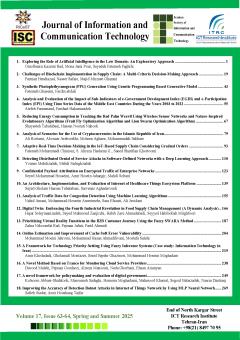Analysis and Evaluation of the Impact of Sub-Indicators of e-Government Development Index (EGDI) and e-Participation Index (EPI) Using Time Series Data of the Middle East Countries During the Years 2003 to 2022
Subject Areas : جامعه الکترونیکیAtefeh Farazmand 1 , Farshad Hakamizadeh 2 *
1 - Head of ICT development planning Research Group, Strategic Studies and Digital Economy Centre, ICT research Institute (ITRC), Tehran, Iran
2 -
Keywords: Keywords: e-government index (EGDI), e-participation (EPI), online services sub-index (OSI), communication infrastructure sub-index (TII), human resources sub-index (HCI),
Abstract :
Electronic and intelligent government aims to connect citizens with various public institutions to provide automated services that reduce cost and time while improving service delivery performance and effectiveness. As a result, measuring e-government performance has become increasingly important to monitor progress and identify opportunities for enhancement across different aspects of citizens’ lives. This study analyzes the performance of the e-government index in the Middle East to explore ways to improve the country's standing. Specifically, it examines the relationship between the main sub-indices of e-government and e-participation using Pearson correlation analysis and the Kolmogorov-Smirnov test to assess data normality, conducted via SPSS software. The findings indicate a significant relationship between the e-government development index and the e-participation index. Among the e-government sub-indices, online services and communication infrastructure are strongly correlated, while the human capital sub-index shows no significant relationship with online services and only a weak correlation with communication infrastructure. Moreover, an analysis of the performance of Middle Eastern countries in these indices from 2003 to 2022 reveals that the United Arab Emirates had the highest overall performance, whereas Libya showed the weakest.
M. P. Gupta and D. Jana, "E-government evaluation: A framework and case study," Government information quarterly, 20(4), pp. 365-387, 2003.
P. Molnár, "Measuring e-government and e-participation.," Budapest, pp. 175-182, 2020.
E. Parliament, Potential and Challenges of E-Participation in the European Union, p. 16., European Parliament, PE 556.949, 2016.
TheWorldBankGroup, "Definition of E-government," The World Bank Group, 2011.
D. Raya & S. Emad, "E-participation levels and technologies," in Sixth International Conference on Information Technology, ICIT 2013, May 2013. pp. 8-10.
M. Z. Sobaci, "What the Turkish parliamentary web site offers to citizens in terms of e-participation: A content analysis," The International Journal of Government & Democracy in the Information Age, 15(3), pp. 227–241, August 2010.
U. Nations, "E-Government Survey 2022," United Nations, 2022. [Online]. Available: https://publicadministration.un.org/egovkb/en-us/Reports/UN-E-Government-Survey-2022.
I. Palaco, M. J. Park, S. K. Kim, and J. J. Rho, "Public–private partnerships for e-government in developing countries: An early stage assessment framework," Evaluation and program planning, vol. 72, pp. 205-218, 2019.
S. Basu, "E‐government and developing countries: an overview.," International Review of Law, Computers & Technology, vol. 18(1), pp. 109-132, 2004.
I. Dhaoui, "E -Government for Sustainable Development: Evidence from MENA Countries," Journal of the Knowledge Economy, vol. 13, 2070–2099, September 2022.
E. F. Kabbar, "A comparative analysis of the e-government development index (EGDI)," in 14th International Conference on ICT, Society, and Human Beings 2021, pp. 23-29, 2021.
M. o. C. o. Russia, Ministry of Communications of Russia, 2017. [Online]. Available: http://minsvyaz.ru/en/activity/statistic/rating/index-razvitiya-elektronnogo-pravitelstva/#tabs|Compare:Place. [Accessed 25 May 2021].
K. Zafiropoulos, I. Karavasilis, V. Vrana, "Assessing the adoption of e-government services by teachers in Greece," Future Internet, vol. 4(2), pp. 528-544, May 2012.
U. Nations, "E-Government Development Index," United Nations, 2022. [Online]. Available: https://publicadministration.un.org/egovkb/en-us/Data-Center. [Accessed 10 1 2024].
N. M. Razali, Y. B. Wah, "Power comparisons of Shapiro–Wilk, Kolmogorov– Smirnov, Lilliefors and Anderson–Darling tests," Journal of Statistical Modeling and Analytics, vol. 2(1), p. 21–33, 2011.
[16] نیک آریا مهران، مازوچی مجتبی، منتظری علی محمد، ایازی فتانه، "بررسی ارتباط بین شاخصهای ارتقای رگولاتوری و شاخص توسعه فاوا، " مديريت اطلاعات، دوره 6، شماره2، اسفند 1399.

